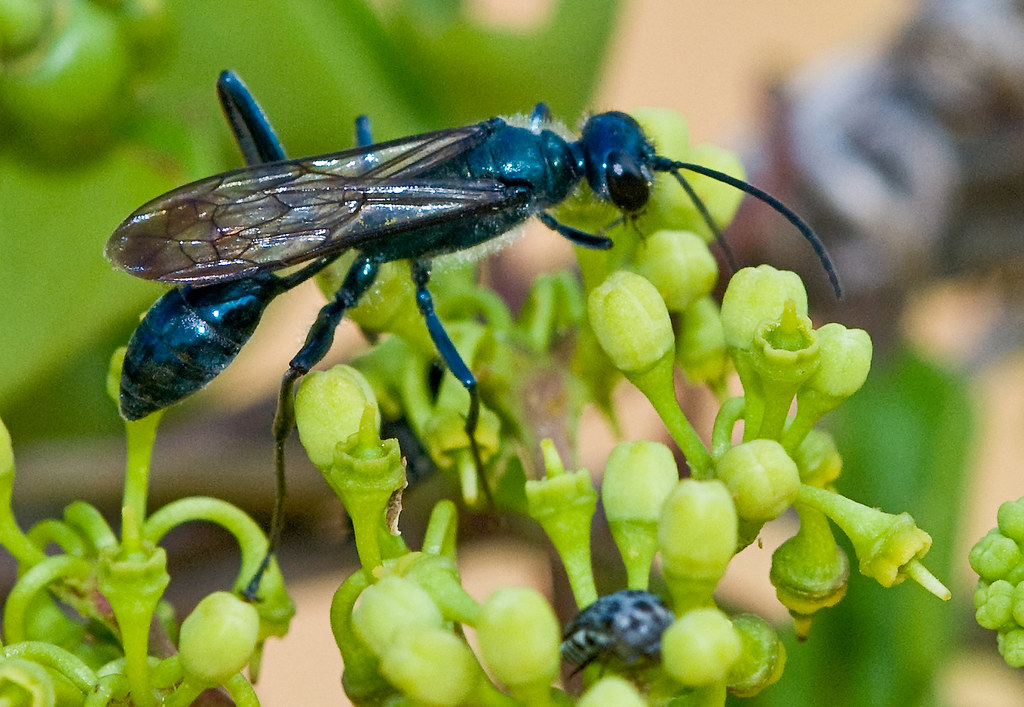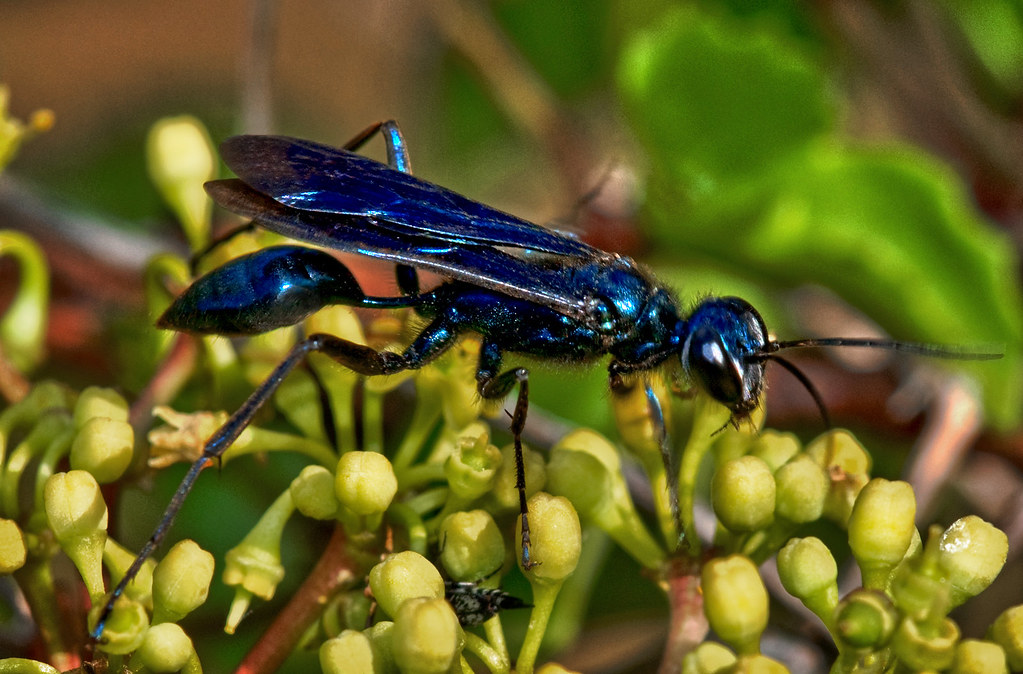
Blue black wasp Discolia soror a photo on Flickriver
The bright yellow color of the wasp is its main identifying feature. The yellow wasps are generally found in Texas, Arizona, and New Mexico. Wasp identification: The yellow wasp is easy to identify due to its yellow color and orange and brown markings. The large yellow wasps grow up to 1.2" (3 cm) long.

Blue Ant male ( Diamma bicolor) Also known as Blue Bottle, this is a male flower wasp is not
The blue ant , also known as the blue-ant or bluebottle, despite its name and appearance, is not an ant, but rather a species of large, solitary, parasitic wasp sometimes known as a flower wasp. It is endemic to south and southeast Australia, including the states of Tasmania, New South Wales, Victoria, and South Australia. It is the sole member of the subfamily Diamminae and the genus Diamma.

Blue bottle fly [ Calliphora vomitoria green bottle fly[ Lucilia sericata ] and common
Wasps of this species are further known for having a metallic color which makes them appear glossy in direct sunlight. As its name implies, this is a species that builds mud nests. The female Nearctic Blue Mud-dauber wasp is mainly responsible for building mud nests. Most females prefer to repurpose old nests as there's not as much work to put in.

Beautiful Bees and Wasps Up Close Arthropods, Insects, Native bees
The Blue Ant is not an ant but a species of flower wasp from the family Tiphiidae. Identification. The wingless, ground-dwelling female Blue Ants are bright metallic blue or green, and can sometimes be mistaken for a large ant. However they are a solitary wasp species, with fully winged males, and can often be found on flowers. Habitat

Metallic blue wasp This is probably Chalybion californicum… Flickr
Description: A type of flower wasp, Blue "ants", aka Bluebottles, have a distinctive metallic blue-green body, with red legs. The female ranges up to 25 mm (1 inch) in length, is wingless and ground-dwelling, and exclusively hunts mole crickets, whereas all other species of tiphiids attack beetle larvae. The male is winged and about half her size.

"blue winged wasp (scolia dubia)" by jude walton Redbubble
Sea Lizards feed on the stinging cells of blue bottles to use them for their own defence. 87895263@N06/flickr, CC BY-SA. Avoiding the sting. In the water, a given blue bottle might not be so easy to see at the far end of a metres-long tentacle, but generally they travel in numbers, so earlier arrivals may be observed strewn along the beach.

Another metallic blue wasp This is a Sphecid wasp, most li… Flickr
A species of North and Central America, Steel-Blue Cricket-Hunter Wasps (Chlorion aerarium) are among the multiple blue wasps of The Americas.. Shiny Blue Bottle Fly. These types of flies (Cynomya cadaverina) are known in North America in the spring months. High activity of Shiny Blue Bottle Flies is also seen in the fall when they seek refuge.

Metallic blue wasp This is a Sphecid wasp, possibly of the… Flickr
Organisms Blow-flies ( Calliphoridae) of genus Calliphora and similar species from other genera Specifically, the blue bottle fly Calliphora vomitoria The Portuguese man o' war ( Physalia utriculus ), stinging marine siphonophores resembling jellyfish and known as bluebottles in Australia, South Africa and New Zealand

Bluebottle wasp! YouTube
This bi-colored insect is actually a type of parasitic wasp. Many varieties of flower wasps have a wingless gender, and this also holds true for them. Not incidentally, it has only a moderate habitat range, however. Like many other insects, this makes it vulnerable to habitat loss and climate change.

Bluebottle approaching wasp on ivy photo WP08486
The Portuguese man o' war ( Physalia physalis ), also known as the man-of-war, [6] is a marine hydrozoan found in the Atlantic Ocean and the Indian Ocean. It is considered to be the same species as the Pacific man o' war or bluebottle, which is found mainly in the Pacific Ocean. [7]

Wasp captures and cuts apart A blue bottle fly YouTube
Blue Winged Wasp, Scolia Dubia—is a Real Asset! Have you seen this wasp flying over the landscape about 12" above the ground, circling in a mass of its fellow wasps? Save for later Print Updated: December 15, 2022 Skip to the end of the images gallery Scolia dubia on goldenrod / David Hill / platycryptus on flickr.com/CC BY 4.0

Bluebottle Fly
The Bluebottle is a common species that often gets washed up onto Sydney beaches in the summer time.

Blue Wasp Animal & Insect Photos Daily Pixels
The blue ant ( Diamma bicolor ), also known as the blue-ant or bluebottle, is a species of flower wasp in the family Thynnidae. [1] It is the sole member of the genus Diamma and of the subfamily Diamminae. Despite its common name and wingless body, it is not an ant but rather a species of large, solitary, parasitic wasp. [2] Distribution

Blue Bottle Ant Actually a female flower wasp, but I think… Flickr
The bluebottle ( Physalia utriculus) is also known as a Pacific man o' war — similar to a Portuguese man o' war, which is found in the Atlantic Ocean. The dangerous part of a bluebottle is the.

Know your wasps — Atlas of Life
The blue bottle wasp is a large Hymenopteran native to Australia. These guys regularly grow to about 2 centimeters (just under an inch) and can pack a painful punch! This gal stung me multiple.

Blue Bottle Fly Bull Skulls, Blue Bottle, Flora And Fauna, Fish Tank, Dark Aesthetic, Bugs
The male Blue Ant has a darker body with white spots on his abdomen. Males are smaller, only growing to 1.5 cm, have wings and can fly. The male Blue Ant behaves more like a wasp, but the female looks and behaves just like an ant. The females live in burrows in the ground, though they will also dart about the garden in an erratic fashion.